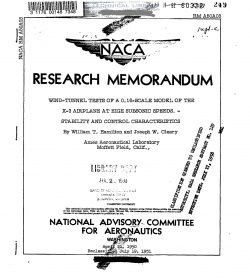naca-rm-a50a03
- Version
- 61 Downloads
- 2.88 MB File Size
- 1 File Count
- April 20, 2017 Create Date
- April 20, 2017 Last Updated
National Advisory Committee for Aeronautics, Research Memorandum - Wind Tunnel Tests of a 0.16 Scale Model of the X-3 Airplane at High Subsonic Speeds. - Stability and Control Characteristics

Static lateral and longitudinalrstability tests were made of a
0.16—scale model of a projected, low—aspect—ratio, supersonic airplane
at low and high subsonic Mach numbers. The wing of the model was
equipped with leading—edge flaps and employed a modified double—wedge
airfoil with sharp leading and trailing edges. An all—movable tail
provided longitudinal control.
The results of the tests show a gradual increase in lift—curve slope
for Mach numbers up to 0.925 and indicate no large decreases in the
stalling lift coefficient throughout the Mach number range of the tests.
Deflecting the leading—edge flaps increased the lift coefficient at the
stall and at the lower Mach numbers improved the drag characteristics.
Although a slight increase in drag coefficient occurred at a Mach number
of 0.925, the Mach number for drag divergence was not reached within
the Mach number range of the test.
The fins, which were intended to stabilize the fuselage nose when
jettisoned for pilot escape, reduced the model stability to such an
extent that their use was considered impractical. Without the nose fins,
the static longitudinal stability was satisfactory and the most forward
position of the neutral point was at approximately 19 percent of the
mean aerodynamic chord at a Mach number of 0.80. The effectiveness of
the tail for providing control was retained to a Mach number of 0.925.
Without the nose fins, the directional stability of the model was
considered high although not excessive for Mach numbers of the test.
This report presents the results of high-speed windrtunnel tests
of a 0.16—scale model of the proJected X93 (Air Force project MXF656)
airplane. This airplane has a low—aspect—ratio wing and tail with sharp
leading and trailing edges and is designed for supersonic speeds.
The tests were conducted at the request of the U. S. Air Force to
investigate the lateral— and longitudinal—stability and control charac—
teristics in the low and high subsonic speed ranges, and were made in the
Ames 16—foot high—speed wind tunnel.
| File | Action |
|---|---|
| naca-rm-a50a03 Wind Tunnel Tests of a 0.16 Scale Model of the X-3 Airplane at High Subsonic Speeds. - Stability and Control Characteristics.pdf | Download |

Comment On This Post